It looks like you're using an Ad Blocker.
Please white-list or disable AboveTopSecret.com in your ad-blocking tool.
Thank you.
Some features of ATS will be disabled while you continue to use an ad-blocker.
Remote viewing & UFOs : Stargate, Galactic Federation + the Aviary (CIA index + 92,010 PDF pages)
page: 1share:
Section A : Introduction
Some interesting people in murky parts of the history of ufology are linked together (at least in part) by their participation in official government studies of remote viewing. I’ve therefore spent a significant amount of time considering remote viewing literature and associated government documents).
To help anyone else going down the remote-viewing rabbit-hole as part of their UFO research (or, for that matter, just interested in remote viewing for its own sake), I thought I'd share a few tools I made in 2014 for my own research (with the kind assistance of remote viewing researcher Palyne "PJ" Gaenir and also from ArMaP here on ATS). These tools include a 92,010 page searchable PDF archive of the remote viewing material released by the CIA and (as importantly, at least in my experience…) a hyperlinked version of the CIA's index of that huge archive to help locate material.
The PDF archive and index are described (with some screen-shots) in ]Section C below, but for those of you impatient get on with browsing or downloading the archive/index then you can:
(1) Browse the hyperlinked index as a spreadsheet on Google Sheets (which can be used online or downloaded in various formats).
(2) Download a Microsoft Excel spreadsheet version of the hyperlinked index with links to the online documents which you can download HERE or (my preferred format, as some of you know…) a searchable PDF version of the same hyperlinked index, created with patient assistance from ArMaP.
(3) Download the entire 92,010 page PDF archive as a a single 3.2 GB file entitled “STARGATE_FULL.zip”), OR you can download individual CDs from the list HERE if you do not want the full collection.
(4) Download a a hyperlinked Excel spreadsheet which links to copies of the documents after you download them to your hard-drive HERE, which is MUCH faster to use (but of course you have to download the rather large PDF archive in order to get the full benefit of this version of the spreadsheet…).

edit on 8-7-2015 by IsaacKoi because: (no reason given)
edit on 8-7-2015 by IsaacKoi because: (no reason
given)
edit on 8-7-2015 by IsaacKoi because: (no reason given)
To understand some elements of Ufology and the characters involved in it, it is useful to look at material relating to remote viewing projects
undertaken by the CIA, NSA, DIA and US Army. This is particular the case in relation to the so-called “Aviary” i.e. various individuals (most of
whom were members of the military or intelligence community) that had contact with ufologist William ("Bill") Moore in the 1980s to whom Bill Moore
gave bird "codenames", such as “Falcon”.
Conspiracy theories relating to “the Aviary” are extremely varied and contradictory. For example, "the Aviary" has been described by Jon King in his book "Cosmic Top Secret" (1998) as "a kind of latter-day Majestic-12 working group", suggesting that the Aviary exists to control information about UFOs. Some other researchers have suggested that the Aviary spread disinformation and hoaxes about UFOs. One online article goes considerably further, asserting that members of the Aviary have:
Various conspiracy theories relating to “the Aviary”, and allegations as to its membership, can also be found in numerous articles online – e.g. in material collated on the Bibliotecapleyades website here, here and here.
However, other researchers have suggested "the Aviary" was basically just a group of people (several of whom had jobs in the military/intelligence sphere) with an informal interest in UFO research.
The nature of the Aviary and the role played by its various members within ufology, particularly Bill Moore and Richard Doty, has been (and remains) highly controversial. Bill Moore and Richard Doty both feature in various allegations of hoaxing within ufology, particularly in relation to the MJ-12 documents. Individuals in “the Aviary” feature in (or being relevant) to a whole host of books (particularly Mark Pilkington’s excellent book “Mirage Men”, Greg Bishop’s interesting “Project Beta”, Robert Collins’s book “Exempt from Disclosure”, Jon Ronson’s amusing “The men who stare at goats”, Howard Blum’s “Out There”, Gary Bekkum's book "Spies, Lies and Polygraph Tape" and various books by members of the Aviary themselves). One of the members of the Aviary, John Alexander, commented in his book “UFOs – Myths, Conspiracies and Realities” that the reality is “actually rather laughable”. For some further discussion of the Aviary, and relevant books, see the introduction to Section H below.
Conspiracy theories relating to “the Aviary” are extremely varied and contradictory. For example, "the Aviary" has been described by Jon King in his book "Cosmic Top Secret" (1998) as "a kind of latter-day Majestic-12 working group", suggesting that the Aviary exists to control information about UFOs. Some other researchers have suggested that the Aviary spread disinformation and hoaxes about UFOs. One online article goes considerably further, asserting that members of the Aviary have:
“reportedly participated in MILABS operations — black operations by rogue military-intelligence units that stalk, harrass, terrorize, kidnap, drug, gang-rape and mind-rape innocent civilians, using hypnotic mind-control programming to implant a false post-hypnotic ‘memory’ that the episode was an “alien abduction.”"
Various conspiracy theories relating to “the Aviary”, and allegations as to its membership, can also be found in numerous articles online – e.g. in material collated on the Bibliotecapleyades website here, here and here.
However, other researchers have suggested "the Aviary" was basically just a group of people (several of whom had jobs in the military/intelligence sphere) with an informal interest in UFO research.
The nature of the Aviary and the role played by its various members within ufology, particularly Bill Moore and Richard Doty, has been (and remains) highly controversial. Bill Moore and Richard Doty both feature in various allegations of hoaxing within ufology, particularly in relation to the MJ-12 documents. Individuals in “the Aviary” feature in (or being relevant) to a whole host of books (particularly Mark Pilkington’s excellent book “Mirage Men”, Greg Bishop’s interesting “Project Beta”, Robert Collins’s book “Exempt from Disclosure”, Jon Ronson’s amusing “The men who stare at goats”, Howard Blum’s “Out There”, Gary Bekkum's book "Spies, Lies and Polygraph Tape" and various books by members of the Aviary themselves). One of the members of the Aviary, John Alexander, commented in his book “UFOs – Myths, Conspiracies and Realities” that the reality is “actually rather laughable”. For some further discussion of the Aviary, and relevant books, see the introduction to Section H below.
edit on 8-7-2015 by IsaacKoi because: (no reason given)
The searchable PDF archive and hyperlinked index (and this covering outlined of some relevant issues) of remote viewing documents will hopefully be
useful to me as an example of my work when I introduce myself to some relevant individuals and seek to resolve some uncertainties relating to the
Aviary…
Apart from being interesting when looking into the Aviary, the remote viewing documents released by the CIA include material relating to the Rendlesham Forest incident (see Section F1 below), the Cash-Landrum incident (see Section F2 below), and other UFO/ET material (see Section F3 below). Some of this material has previously been discussed elsewhere, e.g. on the informative “RemoteViewed” website of Daz Smith and in various books on remote viewing, particularly in Psi Spies by Jim Marrs. Jim Marrs also covered some of this ground in his IUFO presentation in 2011 embedded below:
Apart from being interesting when looking into the Aviary, the remote viewing documents released by the CIA include material relating to the Rendlesham Forest incident (see Section F1 below), the Cash-Landrum incident (see Section F2 below), and other UFO/ET material (see Section F3 below). Some of this material has previously been discussed elsewhere, e.g. on the informative “RemoteViewed” website of Daz Smith and in various books on remote viewing, particularly in Psi Spies by Jim Marrs. Jim Marrs also covered some of this ground in his IUFO presentation in 2011 embedded below:
edit on 8-7-2015 by IsaacKoi because: (no reason given)
As some of you know, the CIA released over 92,000 pages of material relating to “Star Gate” (and various other official remote viewing projects in
the USA, such as "Gondola wish", "Grill flame", "Center Lane" and "Sun Streak") in around 2004 on a series of CDs. Most of the relevant files from
the CIA’s CDs have been available online for some time as TIFF files (i.e. the format in which the files were supplied by the CIA) on various
websites (including on John Greenwald's Blackvault website and on
Palyne "PJ" Gaenir’s DojoPSI website). However, the collections of files on those
websites (and various others) are incomplete, with some key files missing. Also, given the sheer mass of material, it is pretty difficult to find the
files without either a hyperlinked index and/or searchable PDF versions of the files.
Palyne "PJ" Gaenir’s website does include a very useful index for the files, but the index is not hyperlinked to the relevant files (and is not complete) – but that index gave me some ideas for creating various versions of a hyperlinked index using the CIA’s own information. The “Mind-Matter Mapping Project” website also has indexes for various volumes of the Star Gate (with hyperlinks included, but unfortunately they do not work). Several other remote viewing researchers, particularly Tamra Temple, have also made some notable indexes and finding aids available – but (so far as I am aware) those have to be purchased rather than being freely available online. There is also (fairly limited) information on some of these documents on the CIA’s own FOIA website.
So, I put together a more complete collection (with very generous assistance from Palyne "PJ" Gaenir) and converted the CIA’s TIFF files into my preferred format, i.e. searchable PDF files. I also created several versions of a hyperlinked index. I am happy to freely share these resources with others, which will hopefully save some other people a bit of time and effort.
Palyne "PJ" Gaenir’s website does include a very useful index for the files, but the index is not hyperlinked to the relevant files (and is not complete) – but that index gave me some ideas for creating various versions of a hyperlinked index using the CIA’s own information. The “Mind-Matter Mapping Project” website also has indexes for various volumes of the Star Gate (with hyperlinks included, but unfortunately they do not work). Several other remote viewing researchers, particularly Tamra Temple, have also made some notable indexes and finding aids available – but (so far as I am aware) those have to be purchased rather than being freely available online. There is also (fairly limited) information on some of these documents on the CIA’s own FOIA website.
So, I put together a more complete collection (with very generous assistance from Palyne "PJ" Gaenir) and converted the CIA’s TIFF files into my preferred format, i.e. searchable PDF files. I also created several versions of a hyperlinked index. I am happy to freely share these resources with others, which will hopefully save some other people a bit of time and effort.
This thread is split into the following sections:
Section A : Introduction
Section B : Project Stargate – Background
Section C : Project Stargate – PDF archive and index
Section D : Other free remote viewing PDF resources
Section D1 : British Ministry of Defence study
Section D2 : Paul Smith’s PhD dissertation
Section D3 : Eight Martinis remote viewing magazine
Section E : The UFO Connection – Introduction
Section F : The UFO Connection - UFO material in remote viewing files released by CIA
Section F1 : Rendlesham Forest incident
Section F2 : Cash-Landrum sighting
Section F3 : Carl Higdon’s sighting
Section F4 : Cattle mutilation
Section F5 : "MARS, 1 MILLION BC"
Section F6 : "Galactic Federation Headquarters"
Section F7 : "ET ACTIVITY AGAINST US PROGRAMS (TRAINING)"
Section F8 : Fleeting impression of a UFO
Section F9 : Underwater "flying saucer"
Section F10 : "ET Bases" on Earth
Section G : The UFO Connection - Remote Viewers within ufology
Section G1 : Pat Price - Alien bases on Earth
Section G2 : Skip Atwater - Project 8200
Section G3 : Ed Dames - Early public link between UFOs and remote viewing
Section G4 : Uri Geller - Powers from "Spectra"
Section G5 : Ingo Swann - Penetration and barely covered alien bosoms
Section G6 : Joe McMoneagle - UFO sighting in 1965
Section G7 : Lyn Buchanan – Alien abduction (1960s)
Section G8 : Courtney Brown - Hale-Bopp and Heaven’s Gate
Section G9 : Livermore group – Tiny UFO
Section G10 : Mel Riley – Mars
Section G11 : Paul Smith – Mars
Section H : The UFO Connection - Other individuals involved in both ufology and remote viewing
Section H1 : Jacques Vallee (SRI, "Aviary", NIDS)
Section H2 : Hal Puthoff (NSA, SRI, "Aviary", NIDS, UFO Working Group)
Section H3 : Kit Green (CIA, "Aviary", UFO Working Group)
Section H4 : Ron Pandolfi (CIA, "Aviary", UFO Working Group)
Section H5 : John Alexander (US Army, "Aviary", PSI-TECH, NIDS, UFO Working Group)
Section H6 : Dale Graff (DIA, "Aviary")
Section H7 : C B Scott Jones (US Navy, "Aviary")
Section H8 : Major General Albert N. Stubblebine III (US Army, PSI-TECH)
Section H9 : Robert Wood (McDonnell Douglas, UFO Working Group)
Section H10 : Edgar Mitchell (Astronaut, NIDS)
Section H11 : Robert Bigelow (NIDS)
Section H12 : Jim Marrs (Researcher/author)
Section H13 : Jim Schnabel (Researcher/author)
Section H14 : Russell Targ (SRI)
Section I : Conclusion
Anyone unfamiliar with the basic story of America’s remote viewing projects and “Psychic Spies” may enjoy the documentary (“The Real X Files: America's Psychic Spies”) below, written and narrated by Jim Schnabel (see Section H13 below) and featuring many of the key people in the remote viewing field. Schnabel’s amusing book on remote viewing is referred to several times below.
Section A : Introduction
Section B : Project Stargate – Background
Section C : Project Stargate – PDF archive and index
Section D : Other free remote viewing PDF resources
Section D1 : British Ministry of Defence study
Section D2 : Paul Smith’s PhD dissertation
Section D3 : Eight Martinis remote viewing magazine
Section E : The UFO Connection – Introduction
Section F : The UFO Connection - UFO material in remote viewing files released by CIA
Section F1 : Rendlesham Forest incident
Section F2 : Cash-Landrum sighting
Section F3 : Carl Higdon’s sighting
Section F4 : Cattle mutilation
Section F5 : "MARS, 1 MILLION BC"
Section F6 : "Galactic Federation Headquarters"
Section F7 : "ET ACTIVITY AGAINST US PROGRAMS (TRAINING)"
Section F8 : Fleeting impression of a UFO
Section F9 : Underwater "flying saucer"
Section F10 : "ET Bases" on Earth
Section G : The UFO Connection - Remote Viewers within ufology
Section G1 : Pat Price - Alien bases on Earth
Section G2 : Skip Atwater - Project 8200
Section G3 : Ed Dames - Early public link between UFOs and remote viewing
Section G4 : Uri Geller - Powers from "Spectra"
Section G5 : Ingo Swann - Penetration and barely covered alien bosoms
Section G6 : Joe McMoneagle - UFO sighting in 1965
Section G7 : Lyn Buchanan – Alien abduction (1960s)
Section G8 : Courtney Brown - Hale-Bopp and Heaven’s Gate
Section G9 : Livermore group – Tiny UFO
Section G10 : Mel Riley – Mars
Section G11 : Paul Smith – Mars
Section H : The UFO Connection - Other individuals involved in both ufology and remote viewing
Section H1 : Jacques Vallee (SRI, "Aviary", NIDS)
Section H2 : Hal Puthoff (NSA, SRI, "Aviary", NIDS, UFO Working Group)
Section H3 : Kit Green (CIA, "Aviary", UFO Working Group)
Section H4 : Ron Pandolfi (CIA, "Aviary", UFO Working Group)
Section H5 : John Alexander (US Army, "Aviary", PSI-TECH, NIDS, UFO Working Group)
Section H6 : Dale Graff (DIA, "Aviary")
Section H7 : C B Scott Jones (US Navy, "Aviary")
Section H8 : Major General Albert N. Stubblebine III (US Army, PSI-TECH)
Section H9 : Robert Wood (McDonnell Douglas, UFO Working Group)
Section H10 : Edgar Mitchell (Astronaut, NIDS)
Section H11 : Robert Bigelow (NIDS)
Section H12 : Jim Marrs (Researcher/author)
Section H13 : Jim Schnabel (Researcher/author)
Section H14 : Russell Targ (SRI)
Section I : Conclusion
Anyone unfamiliar with the basic story of America’s remote viewing projects and “Psychic Spies” may enjoy the documentary (“The Real X Files: America's Psychic Spies”) below, written and narrated by Jim Schnabel (see Section H13 below) and featuring many of the key people in the remote viewing field. Schnabel’s amusing book on remote viewing is referred to several times below.
edit on 8-7-2015 by IsaacKoi because: (no reason given)
Section B : Project Stargate - Background
The Stargate archive includes a copy of the report by the American Institutes for Research dated 29 September 1995 which gave an overview and evaluation of remote viewing projects. The evaluation was performed by a “blue ribbon” panel. As stated in that report, that panel included Dr. Jessica Utls, a Professor of Statistics at the University of California/Davis, and Dr. Raymond Hyman, a Professor of Psychology at the University of Oregon. In addition to their extensive credentials, they were selected to represent both sides of the paranormal controversy: Dr. Utts had published articles that view paranormal interpretations positively, while Dr. Hyman was selected to represent a more skeptical position.
Back in 1995, both Hyman and Utts appeared on an ABCNews “Nightline” episode about official US remote viewing projects which mentioned the American Institutes for Research report (see the segment on the report at 8 minutes 50 seconds onwards in the video below). Remote viewers were referred to in that item as “Psychic Spies”, a term that has been commonly used since then)
The American Institutes for Research report included the following summary:
In the typical remote viewing experiment in the laboratory, a remote viewer is asked
to visualize a place, location, or object being viewed by a "beacon" or sender. A judge then
examines the viewer's report and. determines if this report matches the target or, alternatively,
a set of decoys. In most recent laboratory experiments reviewed for the present evaluation,
National Geographic photographs provided the target pool. If the viewer's reports match the
target, as opposed to the decoys, a hit is said to have occurred. Alternatively, aecuracy of a
set of remote viewing reports is assessed by rank-ordering the similarity of each remote
viewing report to each photograph in the target set (usually five photographs). A better-than-
chance score is presumed to represent the occurrence of the paranormal phenomenon of
remote viewing, since the remote viewers had not seen the photographs they had described (or
did not know which photographs had been randomly selected for a particular remote viewing
trial).
In evaluating the various laboratory studies conducted to date, the reviewers reached
the following conclusions:
• A statistically significant laboratory effort has been demonstrated in the sense that
hits occur more often than chance.
• It is unclear whether the observed effects can unambiguously be attributed to the
paranormal ability of the remote viewers as opposed to characteristics of the judges
or of the target or some other characteristic of the methods used. Use of the same
remote viewers, the same judge, and the same target photographs makes it
impossible to identify their independent effects.
• Evidence has not been provided that clearly demonstrates that the causes of hits
are due to the operation of paranormal phenomena; the laboratory experiments
have not identified the origins or nature of the remote viewing phenomenon, if,
indeed, it exists at all.
In an operational evaluation, i.e. evaluation of the use of remote viewing in gathering intelligence information, the report concluded:
• The conditions under which the remote viewing phenomenon is observed in
laboratory settings do not apply in intelligence gathering situations. For example,
viewers cannot be provided with feedback and targets may not display the
characteristics needed to produce hits.
• The end users indicated that, although some accuracy was observed with regard to
broad background characteristics, the remote viewing reports failed to produce the
concrete, specific information valued in intelligence gathering.
• The information provided was inconsistent, inaccurate with regard to specifics, and
required substantial subjective interpretation.
• In no case had the information provided ever been used to guide intelligence
operations. Thus, remote viewing failed to produce actionable intelligence.
The overall conclusion of the report of the American Institutes for Research in 1995 was that the observations in the report “provide a compelling argument against continuation of the program within the intelligence community”:
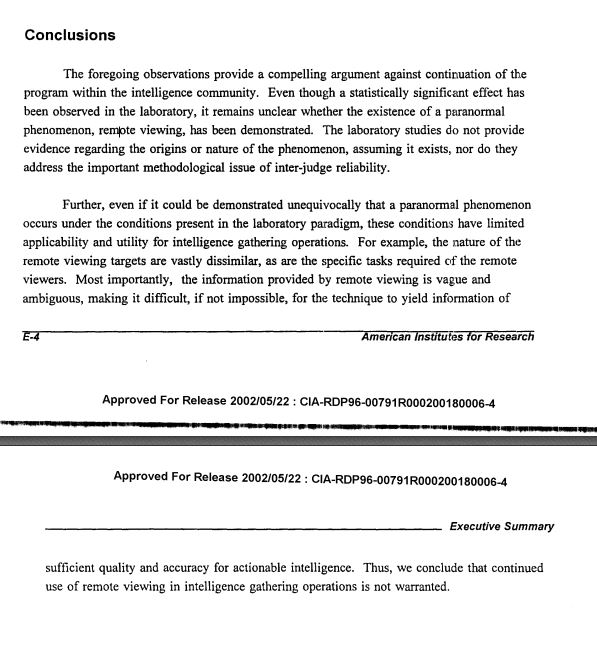
You can form you own view as to those conclusions by reading the relevant report and (more importantly) seeing many of the remote viewing files.
Now that the remote viewing files are readily available online and can easily be located, those arguing against the conclusions in the AIR report should now be expected to give links to specific files that contain evidence to support their contentions.
The Stargate archive also includes MANY briefing and summaries. Most of the relevant briefings appear to have prepared in order to obtain funding
and/or support from various individuals and agencies.
For example, a Defence Intelligence Agency briefing document (containing information formerly classified “Secret, Special Access Information”) provides a relatively brief summary of various military/intelligence remote viewing projects in the USA in the 1970s onwards.
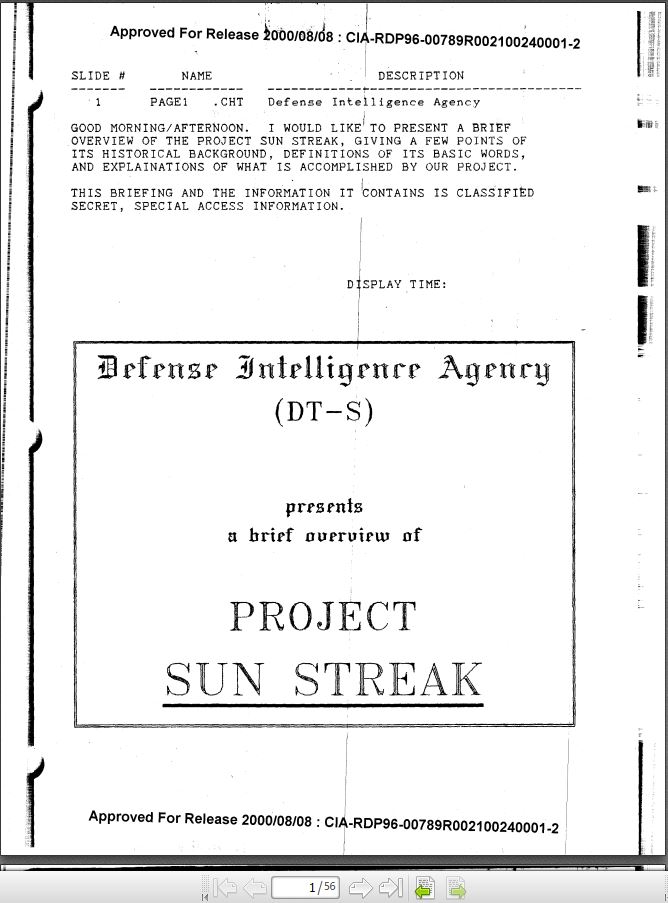
That DIA briefing document included a summary of the (purported) benefits of remote viewing projects:
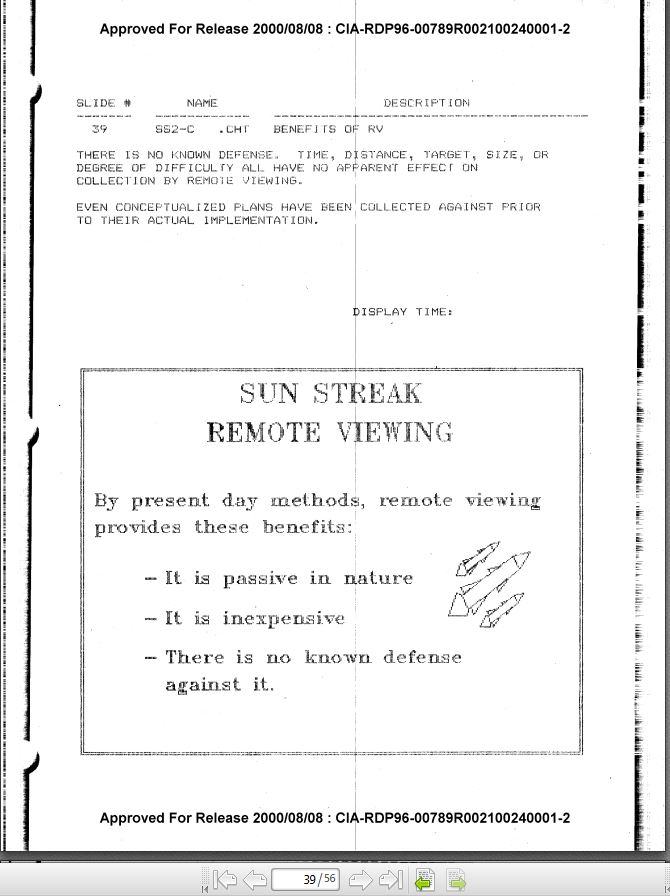
A document from 1985 entitled “Center Lane Information Papers for Director, Defense Intelligence Agency” includes a relatively detailed chronology of the history of some aspects of official remote viewing projects (at pages 30-37 of 37):

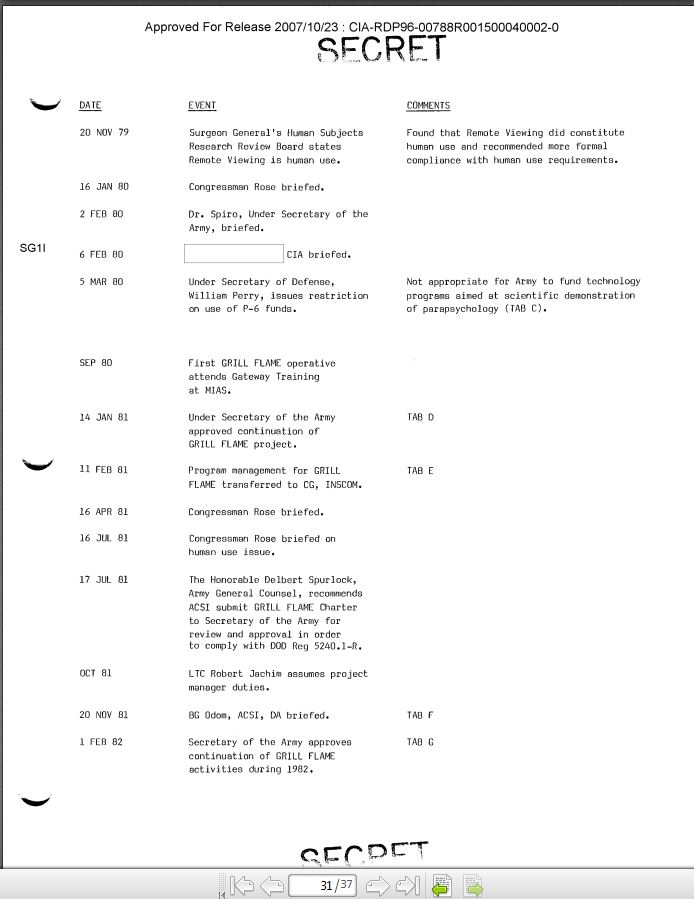
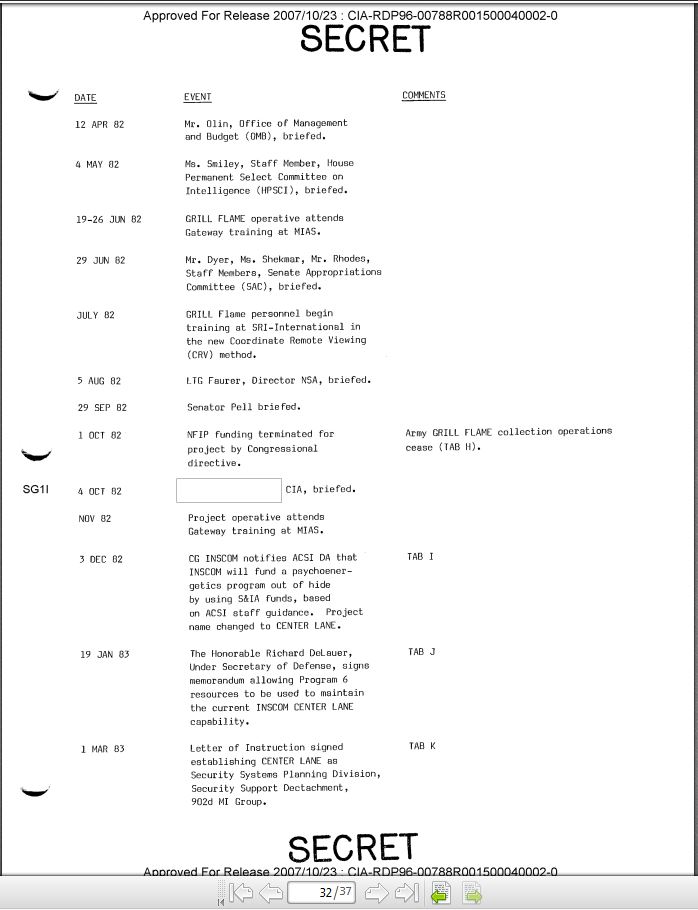
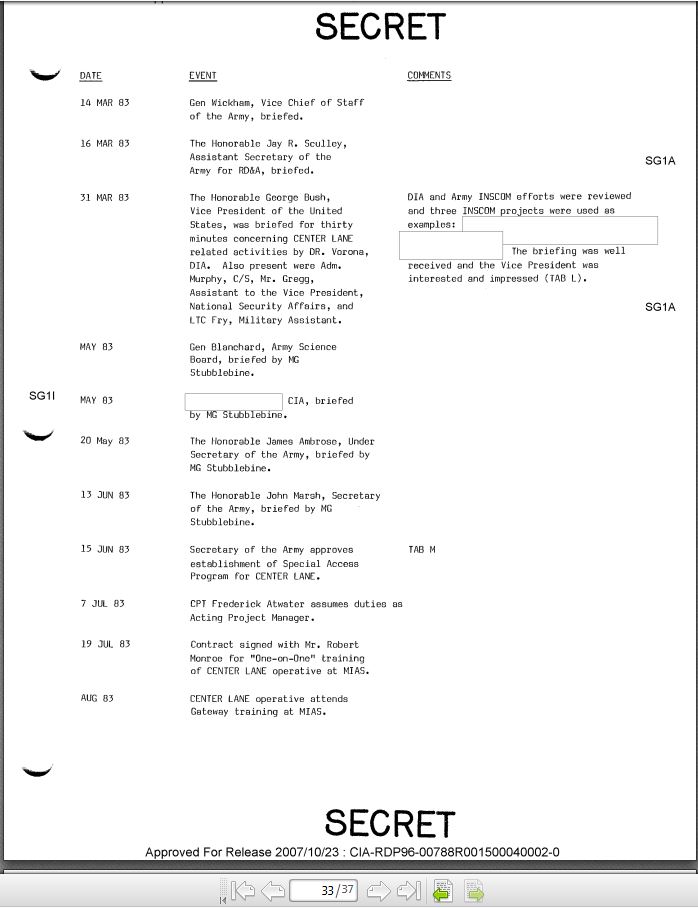
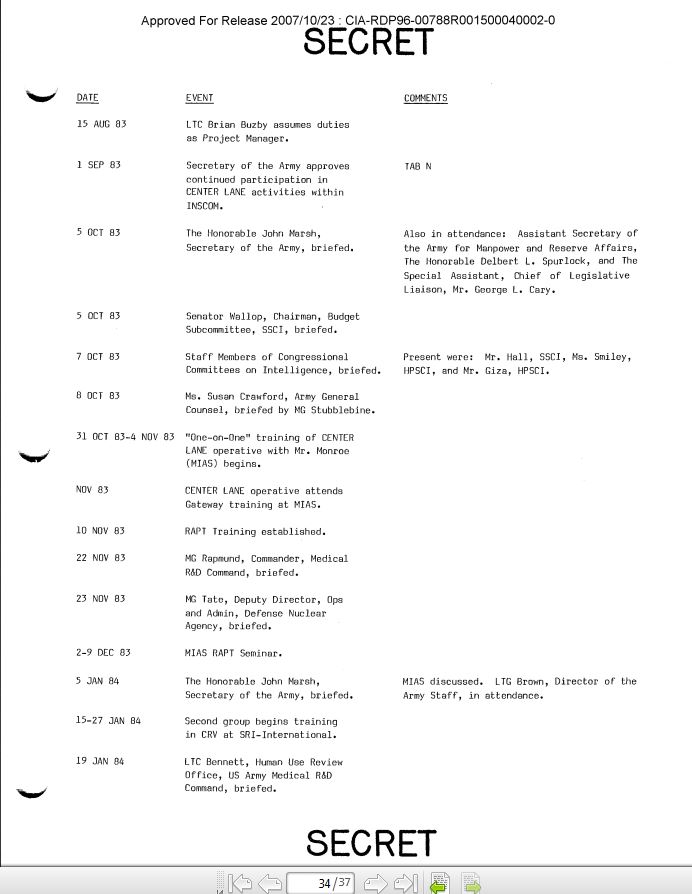

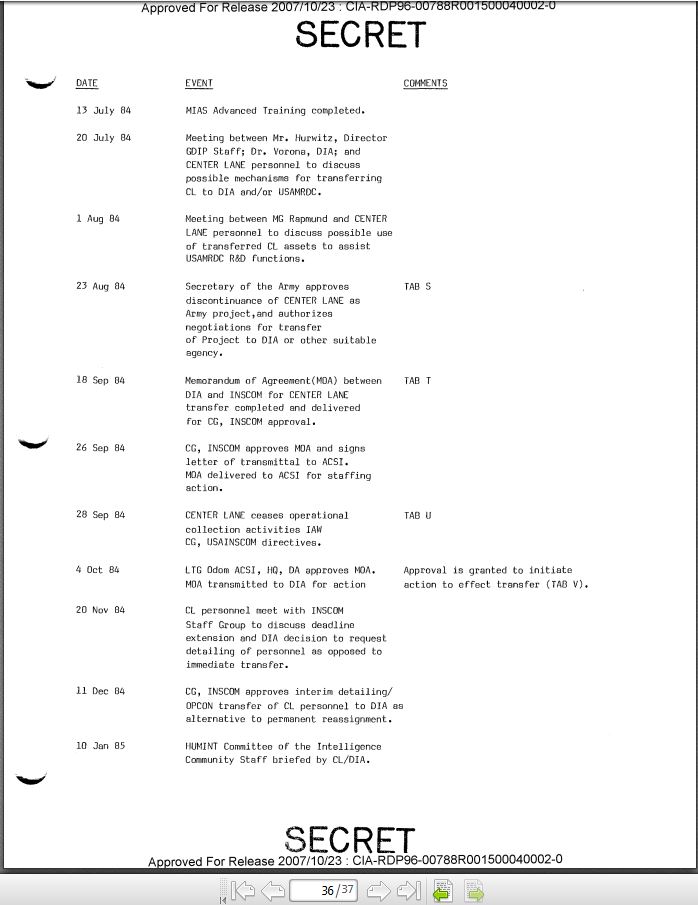
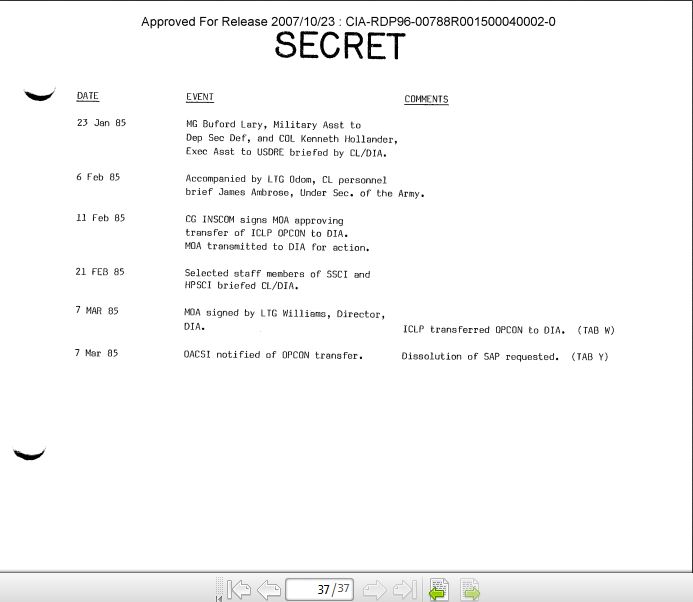
For example, a Defence Intelligence Agency briefing document (containing information formerly classified “Secret, Special Access Information”) provides a relatively brief summary of various military/intelligence remote viewing projects in the USA in the 1970s onwards.

That DIA briefing document included a summary of the (purported) benefits of remote viewing projects:

A document from 1985 entitled “Center Lane Information Papers for Director, Defense Intelligence Agency” includes a relatively detailed chronology of the history of some aspects of official remote viewing projects (at pages 30-37 of 37):








While this thread is about the UFO connections to remote viewing (and my focus below is on highlighting below documents from the Stargate archive in
relation to UFOs), it should of course be recognised that most of the documents in the Stargate archive do not relate to UFOs. Much more typical are
documents relating to attempts to locate crashed planes, drug shipments, hostages and other non-UFO topics, such as
this document relating to an Air
Force "sensitive" individual possibly locating the crash site of a plane or
this “session report”.

The Stargate archive also contains a lot of material about remote into psychic research in other countries, particularly in Russia (such as this document). A quick search of either the index for the Stargate archive (or of the searchable PDF files themselves) will find numerous references to research in the USSR.

The Stargate archive also contains a lot of material about remote into psychic research in other countries, particularly in Russia (such as this document). A quick search of either the index for the Stargate archive (or of the searchable PDF files themselves) will find numerous references to research in the USSR.
edit on 8-7-2015 by IsaacKoi because: (no reason given)
Section C : CIA files - PDF archive and index
I have uploaded the hyperlinked index to the archive released by the CIA as a spreadsheet on Google Sheets (which can be used online or downloaded in various formats).
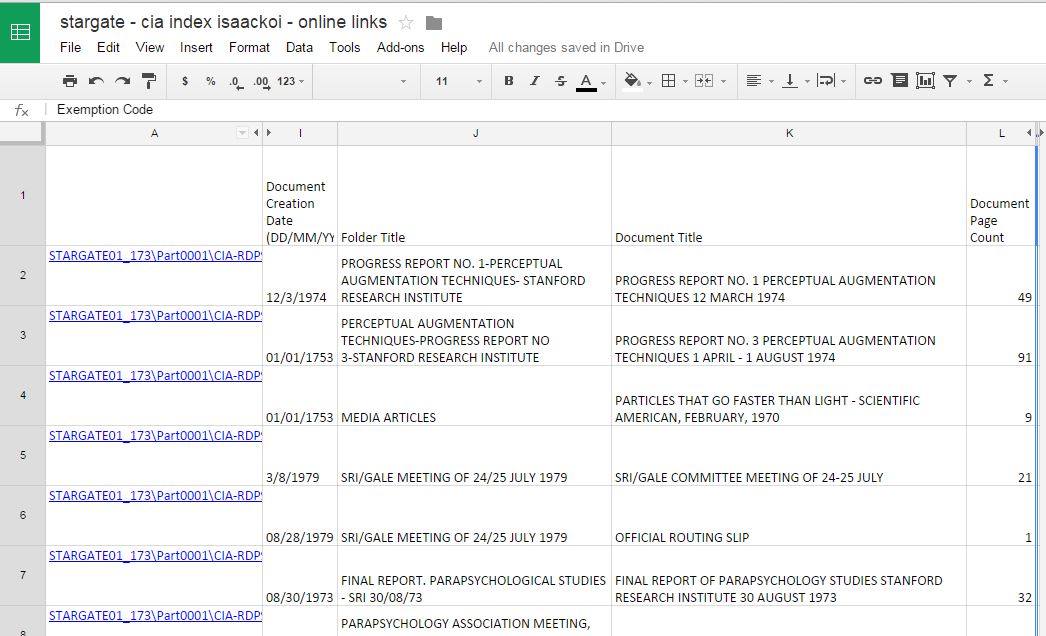
I have also uploaded a Microsoft Excel spreadsheet version of the hyperlinked index with links to the online documents which you can download HERE. With some patient assistance from ArMaP here on ATS, I have also made another version of the spreadsheet with hyperlinks to the online documents, i.e. a searchable PDF version of the same hyperlinked index.

I also have uploaded a version of the hyperlinked Excel spreadsheet which links to copies of the documents after you download them to your hard-drive HERE, which is MUCH faster to use (but of course you have to download the rather large PDF archive in order to get the full benefit of this version of the spreadsheet…).
These indexes are generated using the CIA’s own description of each document. Unfortunately, those descriptions are not 100% accurate. Indeed, some information (particularly in relation to the date the document was generated) is often incomplete or inaccurate. A considerable number of relevant documents are listed by the CIA as being generated in the 1700s!
As some of you familiar with my previous material online may be aware, I generally seek to share resources via free file storage options in an attempt
to demonstrate the ease with which documents can now be freely shared among the UFO community. Unfortunately, the Stargate PDF archive was too large
to successfully make available on any of the free file storage options I tried. (They either had limits on file sizes, duration of storage or were
very slow). I did send messages to John Greenwald a couple of times in August 2014 offering these files to him and his Blackvault website (without any
charge, of course). Since I didn't get any reply from John Greenwald, I've eventually uploaded the files to my own website. (Because of my lack of
interest in sort out technical issues, it took me a while to get around to finally doing this…). John: if you read this, you are of course welcome
to use this material on your website. (For that matter, anyone else is obviously welcome to use any of the Stargate archive on their websites as well
and I include some technical details below on how some of the material could be adapted…).
The 92,010 page searchable PDF archive can be found HERE.
If you want to download of the searchable PDF archive, you may find it quicker and easier to download zipped files of the collection. I’ve uploaded the entire archive as a single 3.2 GB file entitled “STARGATE_FULL.zip”), OR you can download individual CDs from the list HERE if you do not want the full collection.
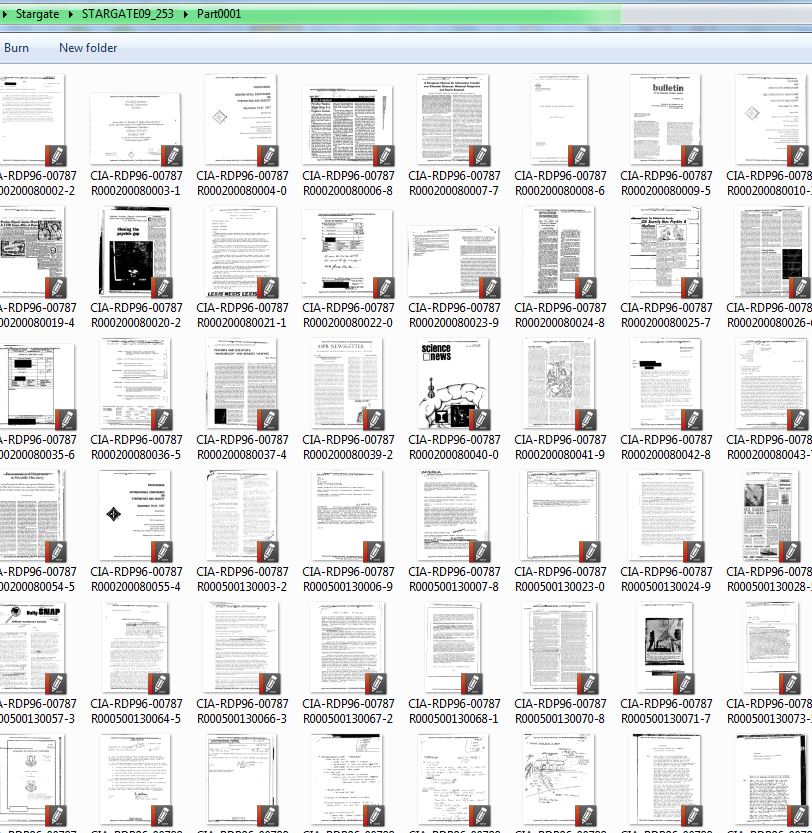
Once the searchable PDF collection is downloaded, you can also run keyword searches of the entire archive using the free software (PDF Xchange Editor) I’ve previously discussed.
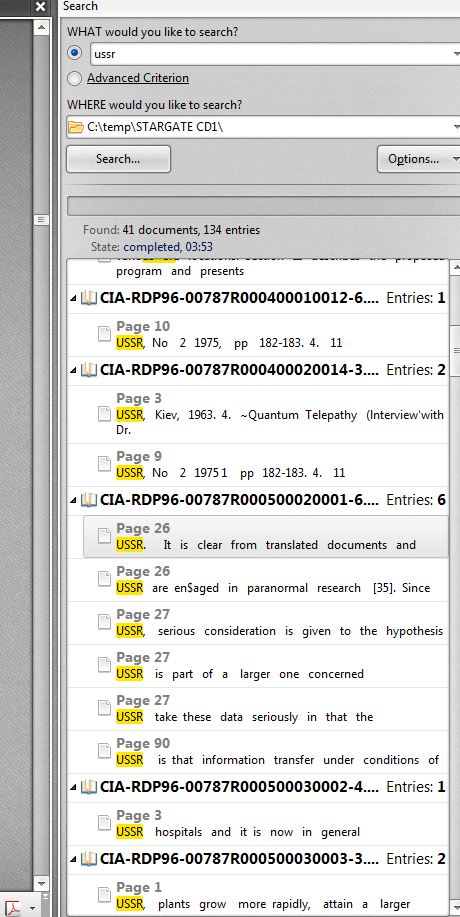
You can rapidly click through any interesting search results to see the relevant keyword in context.
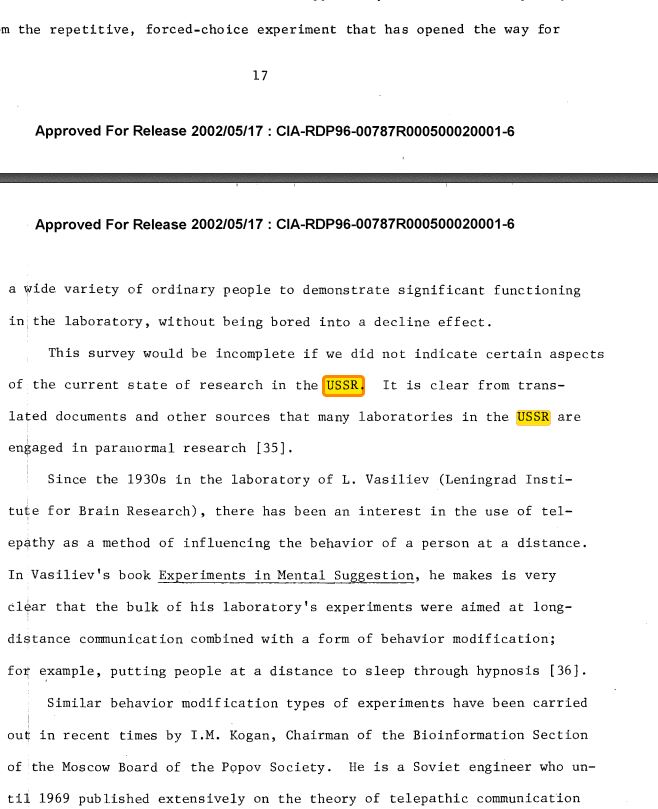
The 92,010 page searchable PDF archive can be found HERE.
If you want to download of the searchable PDF archive, you may find it quicker and easier to download zipped files of the collection. I’ve uploaded the entire archive as a single 3.2 GB file entitled “STARGATE_FULL.zip”), OR you can download individual CDs from the list HERE if you do not want the full collection.

Once the searchable PDF collection is downloaded, you can also run keyword searches of the entire archive using the free software (PDF Xchange Editor) I’ve previously discussed.

You can rapidly click through any interesting search results to see the relevant keyword in context.

The CIA’s dat files used to make the hyperlinked Stargate index are more complicated than the columns displayed in the above screenshots. I have
deliberately set various columns to be “hidden” since I feel certain columns generally take up more space than they deserve. However, it is a
relatively simple matter to “unhide” some or all of the columns (e.g. indicating the previous classification of the documents as secret or
unclassified etc). Some other columns are included merely to help anyone that wants to revise the links to point to a different website or hard-drive
directory (so you can tailor the index in many different ways).
For anyone that would prefer to start from scratch and create their own index using the dat files released by the CIA, I have included the dat files within each relevant archive at the above links. To create your own index from those files, you can duplicate the steps I took (or, quite possibly, adopt a quicker method – after all, I’m a lawyer and unaware of many tricks of the computer trade…):
(1) Open each .dat file in Excel and save as an Excel workbook
(2) Add a column in the individual workbooks giving the source CD in each row
(3) Cut and paste contents of each separate workbook into a single workbook
(4) Add titles to columns, using the CIA's Field Data .dat file.
(5) Rearrange columns and add columns so that first few columns contain the elements of the path name to PDF versions of the relevant files.
(6) Create a new first column inserting a formula which combines the elements of a path name into a single column (e.g. A3=B3&C3&D3&E3&F3&G3)
(7) Highlight all values in the first column and run the macro below to convert the values in the new first column to hyperlinks to the relevant directory or website.
(8) Keep all values in the first column highlighted. Copy and paste them into a new first column, using the paste special option. Paste the contents as values.
(9) Tidy up the appearance of the columns, including altering column widths and formatting the cells to wrap the text of long descriptions.
(10) Hide the various columns that are not desired (e.g the columns used to generate the path URLs in the new first column).
(11) Retain the hidden columns are retained so that they can modified and generate new versions of the URLs used in the first column as desired (e.g. to link to online versions of the documents).
The macro I used to create hyperlinks is based on one on the Excelforum.com website, modified as follows:
Sub ConvertCellTxt2FileLink()
Dim cCell As Range
Dim strURL As String
Dim strLinkText As String
Dim strPrefix As String
Dim strSuffix As String
strPrefix = "" '
For anyone that would prefer to start from scratch and create their own index using the dat files released by the CIA, I have included the dat files within each relevant archive at the above links. To create your own index from those files, you can duplicate the steps I took (or, quite possibly, adopt a quicker method – after all, I’m a lawyer and unaware of many tricks of the computer trade…):
(1) Open each .dat file in Excel and save as an Excel workbook
(2) Add a column in the individual workbooks giving the source CD in each row
(3) Cut and paste contents of each separate workbook into a single workbook
(4) Add titles to columns, using the CIA's Field Data .dat file.
(5) Rearrange columns and add columns so that first few columns contain the elements of the path name to PDF versions of the relevant files.
(6) Create a new first column inserting a formula which combines the elements of a path name into a single column (e.g. A3=B3&C3&D3&E3&F3&G3)
(7) Highlight all values in the first column and run the macro below to convert the values in the new first column to hyperlinks to the relevant directory or website.
(8) Keep all values in the first column highlighted. Copy and paste them into a new first column, using the paste special option. Paste the contents as values.
(9) Tidy up the appearance of the columns, including altering column widths and formatting the cells to wrap the text of long descriptions.
(10) Hide the various columns that are not desired (e.g the columns used to generate the path URLs in the new first column).
(11) Retain the hidden columns are retained so that they can modified and generate new versions of the URLs used in the first column as desired (e.g. to link to online versions of the documents).
The macro I used to create hyperlinks is based on one on the Excelforum.com website, modified as follows:
Sub ConvertCellTxt2FileLink()
Dim cCell As Range
Dim strURL As String
Dim strLinkText As String
Dim strPrefix As String
Dim strSuffix As String
strPrefix = "" '
Incidentally, some of you will have noticed by now that I think basic tools like hyperlinked indexes and catalogues of relevant government governments
may help improve the quality of UFO research and reduce the amount of time and energy wasted reinventing the wheel. With those objective in mind, I
have previously:
(1) Uploaded a sortable/searchable spreadsheet I've created to list the Project Blue Book UFO files on the Fold3 website with an indication of the number of pages per file with links to each of those files (created as a precursor to some potential statistical projects, using the material shared by "Xtraeme" here on ATS):
docs.google.com...
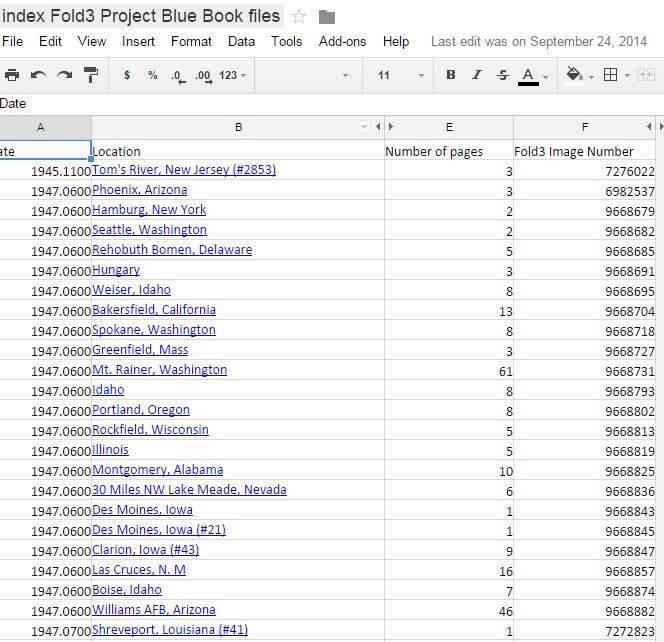
(2) Uploaded a sortable/searchable spreadsheet listing the unredacted Blue Book microfilms that have been uploaded so far to the bluebookarchive.org website (using a hyperlinked and simplified version of an index kindly supplied to be by Rebecca Wise of bluebookarchive.org):
docs.google.com...
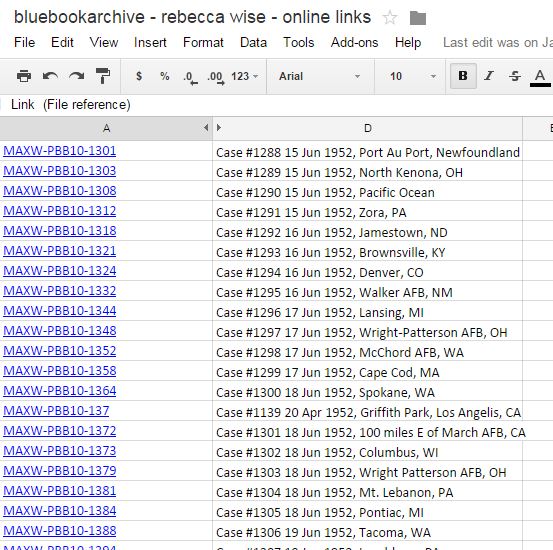
(3) I’ve uploaded redacted high index resolution PDF versions of the US Air Force’s list of Project Blue Book files to:
app.box.com...
(4) I’ve uploaded unredacted low resolution PDF versions ofof the US Air Force’s list of Project Blue Book files (i.e. without all the pesky black ink censoring the names of the relevant witnesses etc…) to:
app.box.com...
(1) Uploaded a sortable/searchable spreadsheet I've created to list the Project Blue Book UFO files on the Fold3 website with an indication of the number of pages per file with links to each of those files (created as a precursor to some potential statistical projects, using the material shared by "Xtraeme" here on ATS):
docs.google.com...

(2) Uploaded a sortable/searchable spreadsheet listing the unredacted Blue Book microfilms that have been uploaded so far to the bluebookarchive.org website (using a hyperlinked and simplified version of an index kindly supplied to be by Rebecca Wise of bluebookarchive.org):
docs.google.com...

(3) I’ve uploaded redacted high index resolution PDF versions of the US Air Force’s list of Project Blue Book files to:
app.box.com...
(4) I’ve uploaded unredacted low resolution PDF versions ofof the US Air Force’s list of Project Blue Book files (i.e. without all the pesky black ink censoring the names of the relevant witnesses etc…) to:
app.box.com...
Section D : Other free remote viewing PDF resources
The searchable PDF archive above containing remote viewing material released by the CIA should provide enough reading material to keep most of those interested in remote viewing until, well, probably until they aren’t interested in remote viewing any more.
However, for good measure, I thought it worth mentioning a few other free PDF resources relating to remote viewing which could be added to the material released by the CIA to make a more comprehensive searchable PDF archive, namely:
Section D1 : British Ministry of Defence study
Section D2 : Paul Smith’s PhD dissertation
Section D3 : Eight Martinis remote viewing magazine
edit on 8-7-2015 by IsaacKoi because: (no reason given)
Section D1 : British Ministry of Defence study
Here in England, in 2007 the Ministry of Defence released a copy of a study its performed of remote viewing in 2001-2007. That report can be downloaded from the relevant part of the Ministry of Defence’s own website.
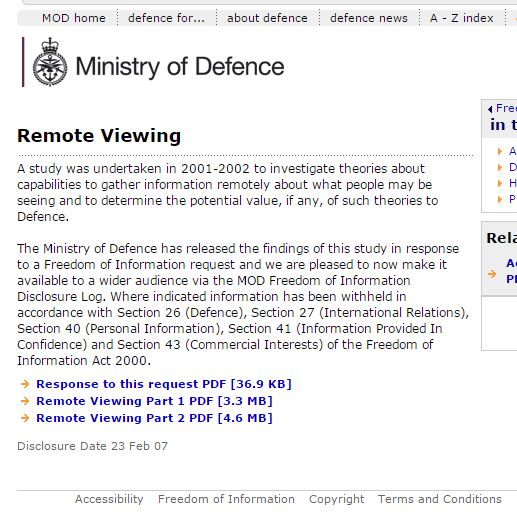
The Ministry of Defence report concluded that the results of the experiments was “undoubtedly disappointing” with “no one achieving any useful performance as a RB subject”.
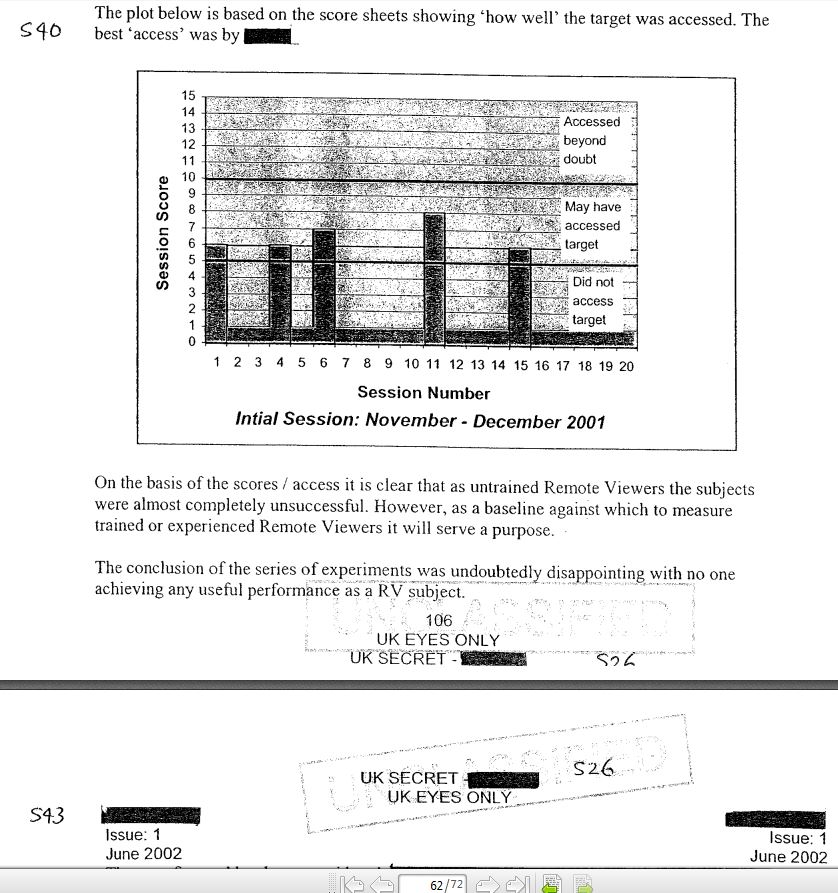
edit on 8-7-2015 by IsaacKoi because: (no reason given)
Section D2 : Paul Smith’s PhD dissertation
Dr Paul Smith (a remote viewer and the author of a detailed book on remote viewing entitled “Reading the Enemy’s Mind”) received a Ph.D in philosophy from the University of Texas at Austin during 2009. His dissertation argued that ESP is evidence that mind is more than simply matter, and referred to various issues relating to parapsychology and remote viewing. His dissertation committee included several leading members of the remote viewing community, including Harold E Puthoff and Jessica Utts.
A PDF copy of that dissertation can be downloaded without charge from the website of the University of Texas.
Here is the table of contents for his dissertation and a sample page.
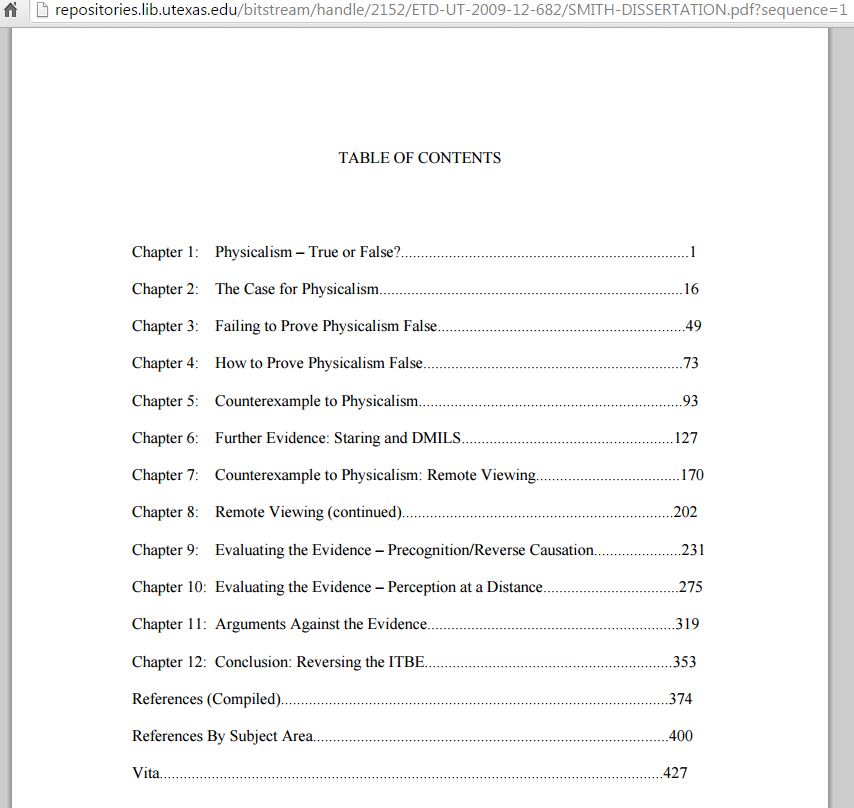
More information about Paul Smith, and other resources he has made available, can be found on his “Rviewer” website and also in various videos online.
Section D3 : Eight Martinis remote viewing magazine
There are currently 12 issues of the “Eight Martinis” remote viewing magazine (edited by Daz Smith) available on the “Eight Martinis” website.
(According to Ingo Swann, an “Eight-martini” result is “an intelligence community in-house term for remote viewing data so good that it cracks everyone’s realities. So they have to go out and drink eight martinis to recover”)
Since its editor (Daz Smith) also has an interest in UFO sightings, it is probably unsurprising that his remote viewing magazine includes quite a few interesting references to UFOs. His interviews of remote viewers typically include at least one question asking them if they have had any UFO sightings, e.g. as can be seen from the sample cover below (from Issue 12 i.e. the January 2015 issue of Eight Martinis).
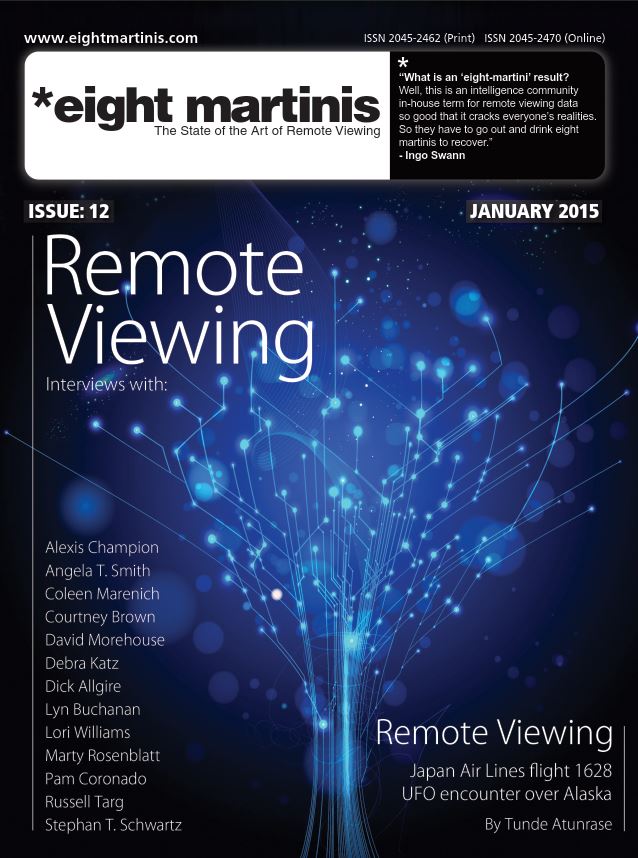
If you download all the issues of the “Eight Martinis” magazine, you can run a search of all those issues for keywords such as “UFO” and then click on the results to see those references in context.
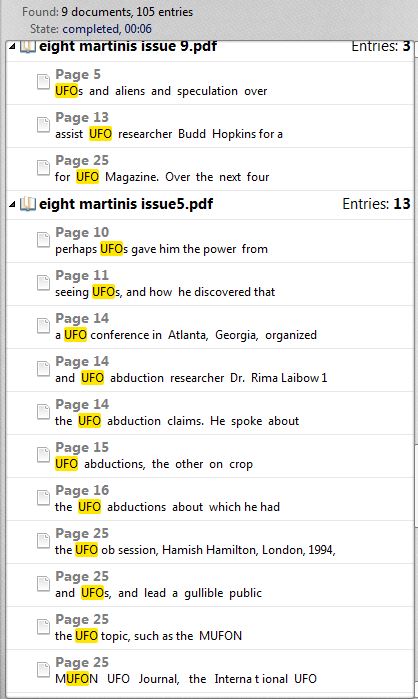
Daz Smith can be seen in the brief video below discussing remote viewing Mars.
Remote viewing is projecting consciousness from body, through paralell space, which is intertwined woth the same spaces we can only experience with 5
senses.
Literally projecting the consciousness out of the body and travelling through space, but the consciousness must be in a different light spectrum when travelling, as the human eyes which are limited to 7 colour mixtures, cannot see consciousness remote viewing.
They could feel something around them or on the field/space their body is existing in, but will be limited to specific light spectrum and won't see those remote viewing.
It's like dream world, how do we experience, sensations, in the dream? How do we see? What light in the dream state is allowing things to be seen? What brain is the dream body using to think and make decisions in this state?
Yet, I can go meet a friend or family member in dream state, if I will it. And we will have experience together, that we will remember upon waking.
I'm saying this to show how RV exists, but csnt be seen or understood while your using/focusing purely on; eyes, ears, taste, touch, smell...
I have remote viewed, in a very stable, balanced, focused state of mind and body under specific conditions for myself.
You can all do it, don't purely depend on 5 senses to understand your universal experience. How did our ancients know and do things the same, being separated millions of miles, across oceans and mountains and wide land?
It's inside ♡
BTW - when I remote viewed (multiple times) it's like looking through glass/window. Like a projecting eyeball (kind of like that on the $1bill), one doesn't interact in this state, they just observe, as far as I know.
Astral projection is the fuller experience of projecting entire consciousness and allowing interaction at some levels, specially with those you may be Astral form with.
Thouhht I would add that tidbit, s&f for research and passion
Literally projecting the consciousness out of the body and travelling through space, but the consciousness must be in a different light spectrum when travelling, as the human eyes which are limited to 7 colour mixtures, cannot see consciousness remote viewing.
They could feel something around them or on the field/space their body is existing in, but will be limited to specific light spectrum and won't see those remote viewing.
It's like dream world, how do we experience, sensations, in the dream? How do we see? What light in the dream state is allowing things to be seen? What brain is the dream body using to think and make decisions in this state?
Yet, I can go meet a friend or family member in dream state, if I will it. And we will have experience together, that we will remember upon waking.
I'm saying this to show how RV exists, but csnt be seen or understood while your using/focusing purely on; eyes, ears, taste, touch, smell...
I have remote viewed, in a very stable, balanced, focused state of mind and body under specific conditions for myself.
You can all do it, don't purely depend on 5 senses to understand your universal experience. How did our ancients know and do things the same, being separated millions of miles, across oceans and mountains and wide land?
It's inside ♡
BTW - when I remote viewed (multiple times) it's like looking through glass/window. Like a projecting eyeball (kind of like that on the $1bill), one doesn't interact in this state, they just observe, as far as I know.
Astral projection is the fuller experience of projecting entire consciousness and allowing interaction at some levels, specially with those you may be Astral form with.
Thouhht I would add that tidbit, s&f for research and passion
edit on 8-7-2015 by Elementalist because: (no reason given)
Section E : The UFO Connection - Introduction
In the sections below, I highlight some of the connections between remote viewing and ufology.
I have tried to break these connections down into three main (admittedly overlapping) categories, i.e.:
Section F : The UFO Connection - UFO material in remote viewing files released by CIA
Section G : The UFO Connection - Remote Viewers within ufology
Section H : The UFO Connection - Other individuals involved in both ufology and remote viewing
Thus, Section F highlights documents in the material released by the CIA relating to the Rendlesham Forest incident, the Cash-Landrum sighting (1980) and other UFO/ET material, whereas Section G deal with the input of various remote viewers to ufology (including claims that alien bases have been remotely viewed here on Earth) and Section H covers various individuals that have played roles in relation to ufology in addition to their roles in relation to remote viewing (including Jacques Vallee, Hal Puthoff, Kit Green, John Alexander and others).
Many of the people covered in Section H are members of the so-called “Aviary” – discussed further in Section H below.
edit on
8-7-2015 by IsaacKoi because: (no reason given)
Section F : The UFO Connection - UFO material in remote viewing files released by CIA
The material in this section is split into the following:
Section F1 : Rendlesham Forest incident
Section F2 : Cash-Landrum sighting
Section F3 : Carl Higdon’s sighting
Section F4 : Cattle mutilation
Section F5 : "MARS, 1 MILLION BC"
Section F6 : "Galactic Federation Headquarters"
Section F7 : "ET ACTIVITY AGAINST US PROGRAMS (TRAINING)"
Section F8 : Fleeting impression of a UFO
Section F9 : Underwater "flying saucer"
Section F10 : "ET Bases" on Earth
edit on 8-7-2015 by IsaacKoi because: (no reason given)
Section F1 : Rendlesham Forest incident
The events in Rendlesham Forest in England during December 1980 are among the best known UFO sightings.
This incident featured as the third best incident in a documentary produced by Paul Kimball entitled “Best Evidence: Top 10 UFO Cases”, purportedly based on the results of a survey conducted by Paul Kimball in 2005/2006 of “a select group of the world’s leading UFO researchers”. This incident came first in an online poll conducted in March/April 2006 by Paul Kimball of “the UFO case with the ‘best evidence’ ever”. This incident is Case 18 in my "Top 100" article, since it was referred to in 89 of the UFO books covered by that article. The Rendlesham incident also featured in a document (“the Rockefeller Briefing Document”) endorsed by Dr Mark Rodeghier (President of CUFOS), Richard Hall (Chairman of FUFOR) and Walter Andrus (President of MUFON) as containing “the best available evidence for the existence of UFOs”. As part of a survey by the Fortean Times in 2007 of various researchers of the ten cases from 1947 onwards that interested them the most, British ufologist Nick Pope described this incident as “probably the world’s most significant UFO case”.
As part of the same survey by the Fortean Times in 2007 of the ten cases from 1947 onwards that interested them the most, this incident featured in lists of cases produced by:
• Stanton Friedman
• jointly by British ufologists Dave Clarke and Andy Roberts
• British ufologist Jenny Randles
• British ufologist Gary Heseltine
I will refrain from uploading all my notes on the Rendlesham Forest incident(s), not least because they amount to a few hundred pages, but for anyone unfamiliar with that case I’ll just briefly give links to the overviews on the relevant Wikipedia page and a thread here on ATS entitled ”The Rendlesham Forest UFO - What really Happened?”. Various documents and resources can be found on MANY other websites, including on Fran Ridge’s excellent NICAP website and on The UFO Evidence website.
The Rendlesham incident also features in a long list of UFO documentaries. (I mean that quite literally : at some point I really should post the long list I’ve compiled of UFO documentaries featuring this incident, since I found that a useful reference document when looking into this incident in some detail a couple of years. Indeed, I should probably write up all my Rendlesham notes and either post them here or write a book. I did suggest the latter possibility, only half-jokingly, to one of the AFOSI agents involved in the investigation of the Rendlesham incident(s) when he kindly responded to my requests for information about that information). One of the various interesting videos online about the Rendlesham incident is the CNN special embedded below:
Some of you may be surprised to learn that the remote viewing documents released by the CIA include a document relating to a session on 14 July 1986 looking into the Rendlesham Forest incident:
www.isaackoi.com...
That document includes several pages from a UFO book discussing the Rendlesham incident (specifically, pages from Chapter 14 of “Clear Intent” by Lawrence Fawcett and Barry Greenwood). That document also includes details of a remote viewing session entitled “Rendlesham Forest Incident”, in which the remote viewer was “LB” (i.e. Lyn Buchanan – see Section G7 below) and the interviewer was “ED” (i.e. Ed Dames – see Section G3 below). I’ll embed a few sample pages from this document below, for ease of reference.
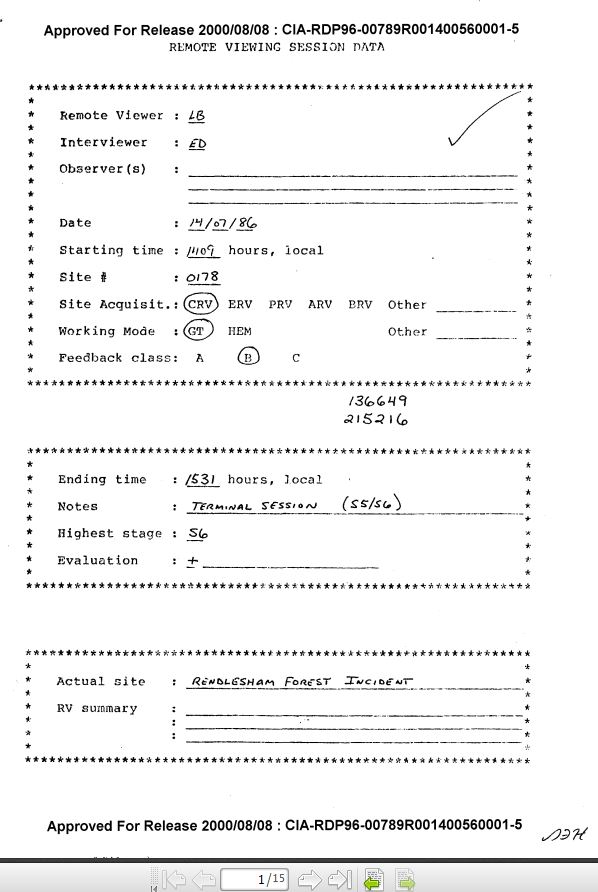
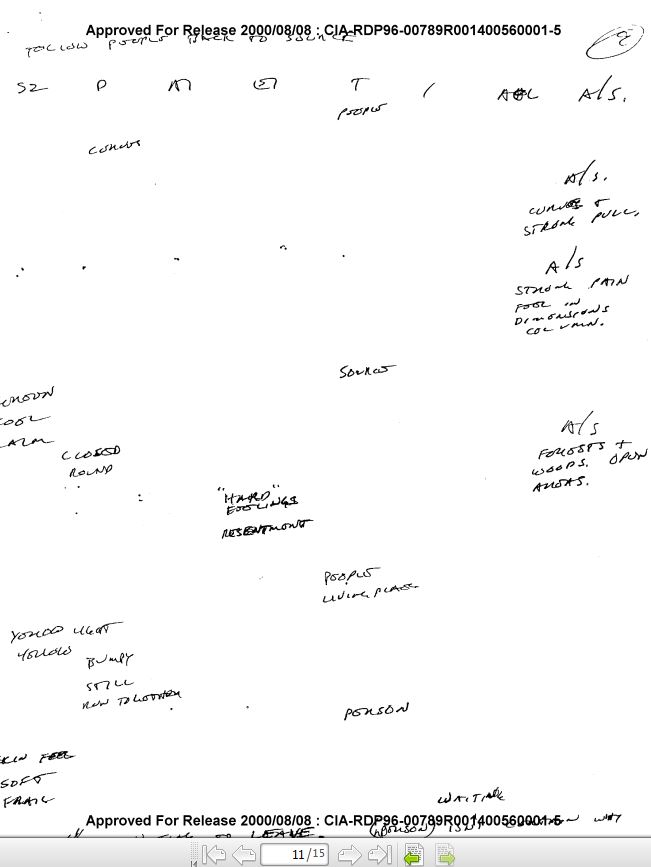
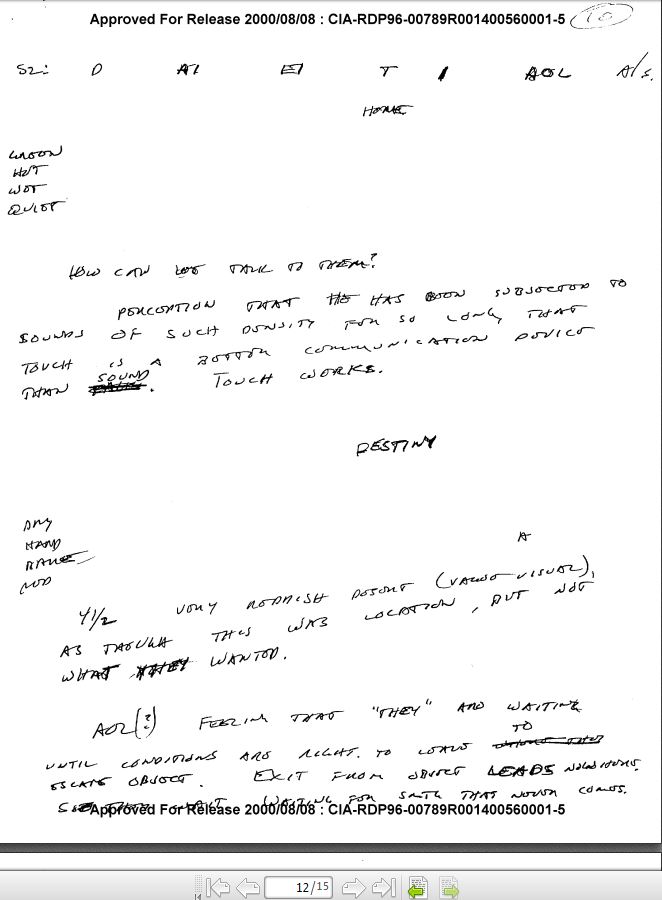
edit on 8-7-2015 by IsaacKoi because: (no reason given)
new topics
-
My Retirement
General Chit Chat: 17 minutes ago -
‘Something horrible’: Somerset pit reveals bronze age cannibalism
Ancient & Lost Civilizations: 1 hours ago -
Spiritual Solstice
Short Stories: 3 hours ago
top topics
-
'Mass Casualty event' - Attack at Christmas market in Germany
Mainstream News: 13 hours ago, 26 flags -
Search to Resume for MH 370
Disaster Conspiracies: 16 hours ago, 5 flags -
Sue Gray, Sir Keir Starmer's former Chief of Staff, Nominated for Peerage
Regional Politics: 17 hours ago, 3 flags -
‘Something horrible’: Somerset pit reveals bronze age cannibalism
Ancient & Lost Civilizations: 1 hours ago, 1 flags -
My Retirement
General Chit Chat: 17 minutes ago, 1 flags -
Spiritual Solstice
Short Stories: 3 hours ago, 0 flags
active topics
-
The Truth Behind the Manchester Airport "Police Assault" Video
Social Issues and Civil Unrest • 57 • : gortex -
My Retirement
General Chit Chat • 0 • : butcherguy -
Biden Nationalizes Another 50,000+ Student Loans as He Heads for the Exit
US Political Madness • 14 • : butcherguy -
'Mass Casualty event' - Attack at Christmas market in Germany
Mainstream News • 107 • : cherokeetroy -
‘Something horrible’: Somerset pit reveals bronze age cannibalism
Ancient & Lost Civilizations • 1 • : Naftalin -
Sue Gray, Sir Keir Starmer's former Chief of Staff, Nominated for Peerage
Regional Politics • 3 • : Freeborn -
Search to Resume for MH 370
Disaster Conspiracies • 8 • : charlyv -
Spiritual Solstice
Short Stories • 2 • : Naftalin -
Mood Music Part VI
Music • 3752 • : BrucellaOrchitis -
An Interesting Conversation with ChatGPT
Science & Technology • 31 • : BrucellaOrchitis
